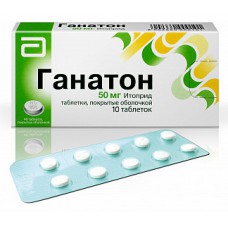Expiration date: 01/2026
Composition and form of release:
Coated tablets. 1 tablet contains:
itopride hydrochloride 50 mg
excipients: lactose-34, 975 mg (including excess due to weight loss during production-2, 93%) corn starch-15, 0 mg carmellose-20, 0 mg anhydrous silicon acid-4, 0 mg magnesium stearate-1, 0 mg hypromellose-4, 4 mg macrogol 6000-0, 4 mg titanium dioxide-0, 2 mg Carnauba wax-0, 025 mg
in blisters of 7, 10 or 14 PCs. in a pack of cardboard 1, 2, 3, 4 or 5 blisters.
Description of the dosage form:
Tablets, coated in white, round, with a risk on one side and the engraving "HC 803" — on the other.
Pharmacokinetics:
Suction. itopride hydrochloride is rapidly and almost completely absorbed from the gastrointestinal tract. Its relative bioavailability is 60%, which is due to the effect of the first passage through the liver. Food does not affect bioavailability.
After taking 50 mg of itopride hydrochloride inside, Cmax is reached after 0, 5-0, 75 h and is 0, 28 mcg/ml. When repeated administration of the drug at a dose of 50-200 mg 3 times/day for 7 days, the pharmacokinetics of the drug and its metabolites were linear, and the accumulation was minimal.
Distribution. Binds to plasma proteins (mainly albumin) by 96%. Binding to & alpha1-acid glycoprotein is less than 15% of the total binding.
It is actively distributed in tissues (the apparent volume of distribution (Vd) is 6, 1 l/kg) and is found in high concentrations in the kidneys, small intestine, liver, adrenal glands and stomach. Penetrates through the BBB in minimal quantities. Penetrates into breast milk.
Metabolism. Itopride undergoes active biotransformation in the liver. 3 metabolites were identified, only one of which shows a small activity that has no pharmacological significance (approximately 2-3% of that of itopride). The primary metabolite is N-oxide, which is formed by the oxidation of a Quaternary amino-N-dimethyl group.
Itopride is metabolized by flavin-dependent monooxygenase (FMO3). The number and effectiveness of FMOZ isoenzymes in humans may differ depending on genetic polymorphism, which in rare cases leads to the development of an autosomal recessive condition known as trimethylaminuria ("fish smell"syndrome). In patients with trimethylaminuria T1/2, itoprid increases.
According to pharmacokinetic studies in vivo, itopride does not have an inhibitory or inducing effect on CYP2C19 and CYP2E1. Itopride therapy does not affect CYP or uridine diphosphate glucuronisyltransferase activity.
Breeding. Itopride hydrochloride and its metabolites are excreted mainly in the urine. Renal excretion of itopride and its N-oxide after a single oral administration in therapeutic doses in healthy people was 3, 7 and 75, 4%, respectively.
The terminal T1 / 2 of itopride hydrochloride is about 6 hours.
Description of pharmacological action:
Itopride hydrochloride increases propulsive motility of the gastrointestinal tract due to antagonism with dopamine D2-receptors and dose-dependent inhibition of acetylcholinesterase activity. Itopride activates the release of acetylcholine and suppresses its destruction.
Itopride hydrochloride has a specific effect on the upper gastrointestinal tract, accelerates transit through the stomach and improves its emptying.
The drug also has an antiemetic effect due to interaction with D2-receptors located in the trigger zone. Itopride causes dose-dependent suppression of vomiting caused by apomorphine.
Itopride hydrochloride does not affect serum levels of gastrin.
Indications:
Relief of such symptoms of functional non-ulcer dyspepsia (chronic gastritis) as:
- bloating
- a sense of rapid saturation
- pain or discomfort in the upper half of the abdomen
- anorexia
- heartburn
- nausea
- vomiting.
Contraindications:
- hypersensitivity to itopride or any auxiliary component of the drug
- gastrointestinal bleeding, mechanical obstruction or perforation of the gastrointestinal tract
- pregnancy
- lactation period (breast-feeding)
- children under 16 years of age.
With caution, the drug should be used in patients for whom the appearance of cholinergic adverse reactions (associated with an increase in the action of acetylcholine under the influence of itopride) may worsen the course of the underlying disease.
Use during pregnancy and lactation:
The use of Ganaton during pregnancy and lactation is possible only in cases where there is no safer alternative, and the expected benefit to the mother outweighs the possible risk to the fetus or child.
Side effect:
- From the hematopoietic system: leukopenia, thrombocytopenia.
- Allergic reactions: skin hyperemia, itching, rash, anaphylaxis.
- From the endocrine system: increased prolactin levels, gynecomastia.
- From the Central nervous system: dizziness, headache, tremor.
- From the gastrointestinal tract: diarrhea, constipation, abdominal pain, increased salivation, nausea, jaundice.
- Changes in laboratory parameters: increased activity of AST and ALT, gamma-glutamyltransferase (GGT), schp and bilirubin levels.
Drug interaction:
Metabolic interaction is unlikely, since itopride is metabolized by OSMOSIS, and not by isoenzymes of the cytochrome P450 system.
When using Ganaton with warfarin, diazepam, diclofenac sodium, ticlopidine hydrochloride, nifedipine and nicardipine hydrochloride, changes in the binding of itopride to proteins were not observed.
Itopride increases the motility of the stomach, so it can affect the absorption of other drugs simultaneously used inside. Special care should be taken when using drugs with a low therapeutic index, as well as forms with delayed release of the active substance or drugs with an intestinal-soluble shell.
Anti-ulcer agents such as cimetidine, ranitidine, teprenone and cetraxate do not affect the prokinetic effect of itopride.
Anticholinergic agents can weaken the effect of Ganaton.
Dosage and administration:
Inside, adults-50 mg (1 table) 3 times a day before meals. The recommended daily dose is 150 mg. The indicated dose may be reduced taking into account the age of the patient.
Overdose:
Cases of overdose in humans are not described.
Treatment: in case of possible overdose, gastric lavage and symptomatic therapy are indicated.




